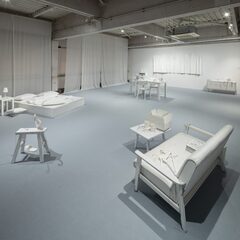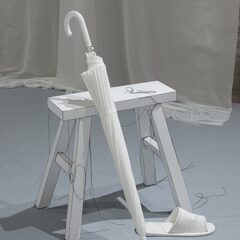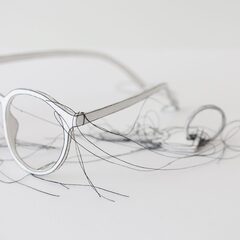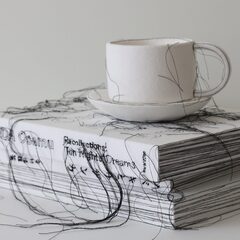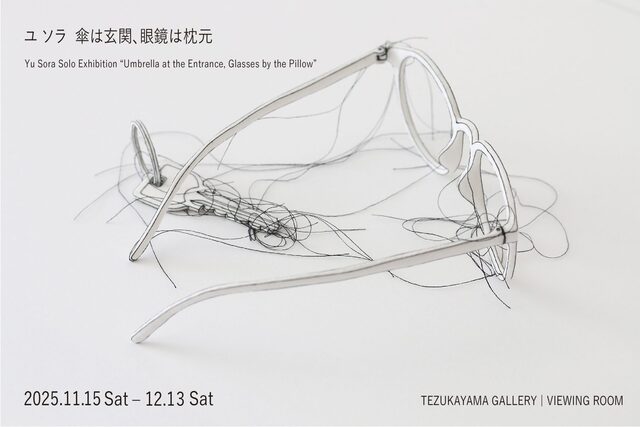
Viewing Room
Umbrella at the Entrance, Glasses by the Pillow
Yu Sora
2025.11.15 Sat - 2025.12.13 Sat
TEZUKAYAMA GALLERY is pleased to present Yu Sora: Umbrella at the Entrance, Glasses by the Pillow, the artist’s first solo exhibition at the gallery, opening on November 15.
Born in 1987 in Gyeonggi-do, Korea, Yu Sora graduated from the Department of Sculpture at Hongik University in 2011 and completed her M.F.A. in Sculpture at Tokyo University of the Arts in 2020. She currently lives and works in Japan.
Yu Sora explores themes of “everyday life” and “fleeting moments” — aspects of daily existence that may suddenly be lost due to disasters or accidents. Her three-dimensional and two-dimensional works are composed of black thread embroidered onto white cloth. Through these delicate stitched images of landscapes and everyday objects, she evokes layers of memory and invites reflection on the fragility and form of daily life.
Her works can be seen as drawings rendered not with pencil and paper, but with fabric, thread, and a sewing machine. Depicting familiar items and spaces — keys, chairs, beds, dishes, and domestic interiors — Yu Sora traces the passage of time and the subtle presence of human memory through their forms and textures. The soft materials and intricate stitching serve as a means to visualize the sensations and impressions embedded within her subjects.
The exhibition title, Umbrella at the Entrance, Glasses by the Pillow, reflects Yu Sora’s interest in the dual sensations of “safety” and “relief” that inhabit our living spaces. Everyday objects that quietly accompany our lives — like umbrellas or glasses — also gesture toward absence and loss. The world Yu Sora constructs through her work becomes a site where the physical “home” and the psychological “place of being” intersect, gently revealing the relationship between the interior and the exterior, the self and society.
_
[Artist Statement]
When I entered university, I left my family and began living alone in an old semi-basement room in Seoul. The room was filled with secondhand appliances from a recycling shop and the same desk I had used since elementary school. Although I had my share of worries at twenty, the room overflowed with dreams and happiness. I loved that room, and I loved who I was in it, so I began to draw the inside of the room.
The form of a comfortable room differs for everyone. Some feel calm when the bed or chair is piled with things as long as the floor is clear, others need their desk to be tidy even if objects scatter across the floor. The reason I have focused mainly on scenes from “inside the home” is because that is where I feel most at peace. Even for those who come home late and leave early for work, the home accepts them, it is where tension dissolves. When the heart feels frayed or anxious, the disorder of the room often reflects it. Tidying up, even a little, can sometimes bring the mind to rest.
If “safety” and “relief” were to take form, I think it would be each become a person’ s “room”. I began drawing such room of comfort, but at some point, I realized I was also speaking about anxiety.
Events that suddenly erase a person’s life or daily routine still happen somewhere in the world or right beside us. Disasters, accidents pandemics, wars – forces beyond human control. The fear that something might happen at any time lies quietly at the bottom of my heart. Since having a child, that fear has doubled along with the happiness I want to protect. At times, even the smallest worry ripples through my everyday life. What I once thought of as ordinary life, the same faces, the same places revealed itself to be as fragile as a building made of paper.
Now, rather than drawing my own room, I look for rooms that could belong to anyone. I avoid color so that anyone might project their own daily life onto the scene, and I think about the things that someone, somewhere keeps repeating in their “usual” days. An umbrella by the entrance, glasses by the pillow, crumpled receipts, clothespins rolling on the floor, and objects resting on top of books stacked unread. Seeing that “we are all the same” brings a small comfort, yet the threads tracing the room’s outlines sway slightly when someone comes close, as if one wrong pull could unravel everything into a blank white nothingness. The size and texture of anxiety differ from person to person, within this white room, some may find only peace.
If it’s something that cannot be erased, I want to face that anxiety, look it in the eye, and take its hand. I want to let relief and unease coexist. I hope to share even a little understanding with those who live with similar fears. With such feelings, I continue to create these white rooms.
Yu Sora
